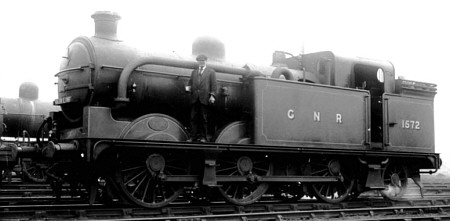The Ivatt N1 0-6-2T Locomotives

Ivatt introduced his N1 0-6-2T design for hauling suburban London trains, after the unsuccessful introduction of his R1 0-8-2T class. The first N1, No. 190 appeared in 1907 but proved too heavy for the Metropolitan Widened Lines, and was quickly moved to the West Riding. The rest of the class was built with a slightly longer frame and with the radial wheels set further back. The coal bunker and side tanks were re-modelled, with an overall effect of moving the weight towards the rear. Although the maximum axle load was still high, the design changes appear to have been a success and by 1912 a total of 51 N1s were operating in the London area. A total of 56 N1s were built in six batches. All were fitted with condensing gear, except for four which were intended for use in the West Riding.
The production N1s had side tanks that were 3ft 5.25in shorter. This was compensated for by increasing the size of the water tank situated in the bunker. The coal and water capacities remained the same, but the weight was moved further back onto the radial axle.
In 1908, Ivatt used the same boiler, wheels, and motion in his J1 0-6-0 mixed traffic locomotive. The boiler was also used in the J5 0-6-0 and D2 4-4-0 locomotives.

The only significant modification was the fitting of superheaters to eleven N1s between 1918 and 1928. Two were fitted with Schmidt superheaters before Grouping (1923). After Grouping, Robinson superheaters were fitted instead, and the Schmidt superheaters were replaced with Robinson superheaters.
Most of the N1s were initially allocated to the London area for their intended suburban workings. They also hauled transfer goods trains across to South London.
During World War 1, two N1s were sold to the War Office. These were repurchased by the LNER in March 1923.
By Grouping (1923), the N2s had started to replace them on the heavier and more intensive workings. By the mid-1920s, the N1s had stopped hauling passenger services and were limited to coal transfers and empty carriage workings.

In 1923, the West Riding allocation stood at thirteen. The re-allocated locomotives had their condensing gear removed in 1921, although some of them still carried the condensing pipes until the mid-1920s. Further transfers to the West Riding occurred in the 1920s, and were usually accompanied by further removals of the condensing gear. West Riding workings included passenger services between Leeds, Bradford, and Wakefield. During the 1930s, the N1s could be found on virtually all the shorter passenger routes in the county. They also operated as station pilots at Leeds and Wakefield.
Although superceded by Gresley's N2 locomotives with their superheating and piston valves, the first withdrawal did not occur until 1947. One locomotive was withdrawn in 1947, leaving 55 engines to enter British Railways ownership. Withdrawals commenced in earnest in 1951. Although they were replaced by J50s on many of the transfer workings, the widespread introduction of diesel multiple units hastened their withdrawal in the West Riding. The last N1 was withdrawn in April 1959.
Technical Details
The pioneer locomotive, No. 3190 (GNR No. 190) was slightly shorter (35ft 7.5in) and slightly lighter (64t 14cwt).
| Saturated | Superheated | ||
| Cylinders (x2): | (inside) | 18x26in. | 18x26in. |
| Motion: | Stephenson | slide valves | slide valves |
| Boiler: | Max. Diameter: | 4ft 8in | 4ft 8in |
| Pressure: | 175psi | 170psi | |
| Diagram No.: | 7 | 7 | |
| Heating Surface: | Total: | 1250 sq.ft. | 1129 sq.ft. |
| Firebox: | 120 sq.ft. | 118 sq.ft. | |
| Tubes: | 1130 sq.ft. (238x 1.75in) | 562 sq.ft. (118x 1.75in) | |
| Superheater: | 192 sq.ft. (18x 1.25in | ||
| Flues: | 257 sq.ft. (18x 5.25in) | ||
| Grate Area: | 19 sq.ft. | 19 sq.ft. | |
| Wheels: | Coupled: | 5ft 8in | 5ft 8in |
| Trailing: | 3ft 8in | 3ft 8in | |
| Tractive Effort: | (@ 85% boiler pressure) | 18,427lb | 17,900lb |
| Total Wheelbase: | 23ft 9in | 23ft 9in | |
| Engine Weight: | (full) | 65 tons 17cwt | 65 tons 17cwt |
| Max. Axle Load: | 18 tons | 18 tons | |
| Coal Capacity: | 4 tons 0cwt | 4 tons 0cwt | |
| Water Capacity: | 1600 gallons | 1600 gallons |
Preservation
The last seven N1s were withdrawn in 1959, and none survived into preservation.
Models
London Road Models sell a 4mm kit of the N1. WSM have produced a kit of the N1 for OO gauge (4mm scale), but current availability is unknown.
ACE Products sell a kit of the N1 for 7mm scale (O gauge).
Acknowledgements
Thank you to Mike Morant Collection for the colour illustration of No. 1560.
Thank you to Malcolm Peirson for the photographs of GNR No. 1572 & LNER No. 4588.